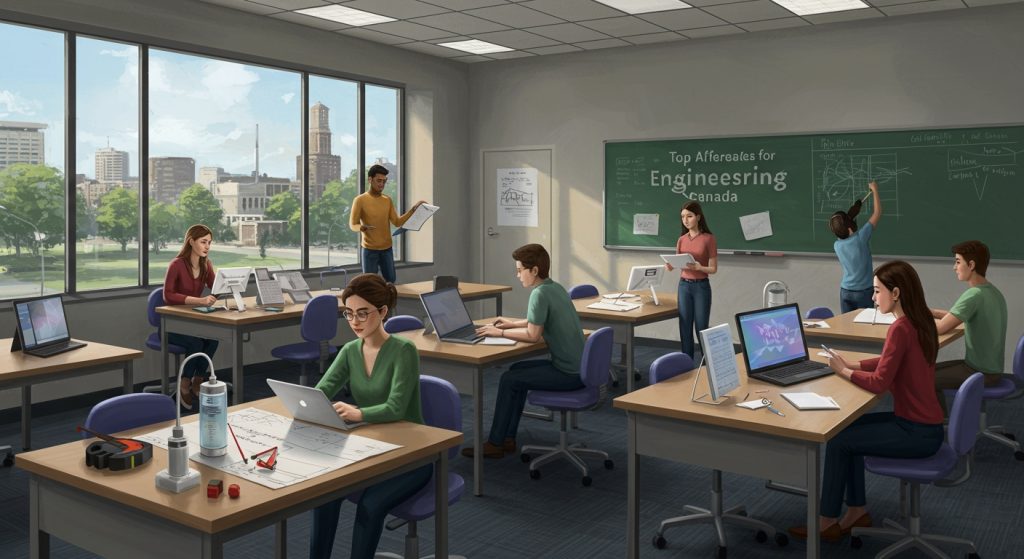Landing a spot in a top-tier engineering program is more competitive than ever. Acceptance rates at leading universities like MIT and Stanford, hovering around 4-8% for some disciplines, highlight the intense demand. This isn’t just about stellar grades; universities are increasingly looking for well-rounded applicants with impactful extracurriculars and demonstrable passion projects, especially in fields like AI and sustainable engineering which are seeing explosive growth. Understanding the statistical landscape, from average GPAs to standardized test score ranges for accepted students at your target schools, is crucial. Knowing these benchmarks empowers you to strategically position your application and navigate the increasingly selective engineering admissions process, giving you a significant edge.

Understanding Engineering Program Acceptance Rates
Gaining admission to an engineering program can feel like a monumental achievement. But before you celebrate, it’s wise to comprehend the landscape of university acceptance rates. These rates represent the percentage of applicants who are offered admission, providing a glimpse into the competitiveness of a particular program. A lower acceptance rate generally indicates a more selective program, attracting a large pool of highly qualified candidates. Conversely, a higher acceptance rate might suggest a less competitive environment, although it doesn’t necessarily reflect the quality of the engineering education offered.
Factors Influencing Acceptance Rates
Several factors contribute to the variability in acceptance rates across different engineering programs and universities:
- University Reputation and Ranking: Prestigious universities with strong national or international rankings often attract more applicants, leading to lower acceptance rates.
- Program Specialization: Certain engineering specializations, like computer engineering or biomedical engineering, may be more popular than others, resulting in a higher number of applicants and a lower acceptance rate.
- Program Capacity: The number of available spots in a program significantly impacts the acceptance rate. Programs with limited resources or a deliberate focus on smaller class sizes will naturally have lower rates.
- Geographic Location: Universities located in desirable cities or regions often receive more applications, contributing to lower acceptance rates.
- Application Requirements: Stringent admission requirements, such as high GPA thresholds, standardized test scores, or specific prerequisite coursework, can filter out some applicants, potentially affecting the acceptance rate.
- University Resources: The availability of research labs, state-of-the-art equipment. Experienced faculty can draw a larger pool of applicants, thereby influencing the acceptance rate.
Navigating University Statistics: A Closer Look
When evaluating engineering program acceptance rates, it’s essential to dig deeper than just the overall number. Consider these aspects:
- Specific Engineering Disciplines: Acceptance rates can vary significantly within the same university depending on the engineering discipline (e. G. , mechanical, electrical, civil). Always research the acceptance rate for your specific area of interest.
- Undergraduate vs. Graduate Programs: Acceptance rates for graduate engineering programs are often lower than those for undergraduate programs due to the more specialized nature of graduate studies and the smaller number of available positions.
- International vs. Domestic Students: Some universities have different acceptance rates for international and domestic students, reflecting institutional priorities and quotas.
- Early Admission Programs: Applying through early admission programs can sometimes increase your chances of acceptance, as these programs often have higher acceptance rates than regular admission. But, early admission usually requires a binding commitment to attend if accepted.
Benchmarking Acceptance Rates: Examples from Top Universities
While specific acceptance rates fluctuate annually, examining historical data from top-ranked engineering schools provides a valuable benchmark.
Example: Massachusetts Institute of Technology (MIT)
MIT’s undergraduate acceptance rate is consistently among the lowest in the nation, often hovering around 4-8%. This reflects the university’s exceptional reputation and the highly competitive applicant pool.
Example: Stanford University
Stanford’s engineering programs are also highly selective, with undergraduate acceptance rates typically in the 4-6% range.
Example: University of California, Berkeley
UC Berkeley’s College of Engineering has a slightly higher acceptance rate than MIT or Stanford, often in the 8-12% range. Remains highly competitive, particularly for out-of-state and international applicants.
Example: Georgia Institute of Technology
Georgia Tech, a public institution with a strong focus on engineering and technology, generally has a higher acceptance rate than private universities like MIT or Stanford, typically in the 20-25% range.
Note: These figures are approximate and can change from year to year. Always consult the university’s official website for the most up-to-date details.
The Holistic Application Review Process
While acceptance rates offer a quantitative measure of competitiveness, it’s crucial to remember that admissions decisions are rarely based solely on numbers. Universities employ a holistic review process, considering a wide range of factors beyond GPA and test scores.
- Academic Performance: Rigorous coursework, high grades in math and science. A strong overall GPA are essential.
- Standardized Test Scores: While some universities are becoming test-optional, strong scores on the SAT or ACT can still enhance your application.
- Extracurricular Activities: Participation in engineering-related clubs, competitions (e. G. , robotics, science Olympiad). Research projects demonstrates your passion for the field.
- Letters of Recommendation: Strong letters of recommendation from teachers and mentors who know you well can provide valuable insights into your abilities and character.
- Essays and Personal Statements: The essay is your opportunity to showcase your personality, motivations. Unique experiences. It’s a chance to demonstrate your writing skills and articulate why you’re a good fit for the program.
- Interview (if applicable): Some programs require interviews to assess your communication skills, problem-solving abilities. Overall fit with the university culture.
Beyond Acceptance Rates: Evaluating Program Quality
While a low acceptance rate can indicate prestige, it doesn’t necessarily guarantee a superior educational experience. Consider these factors when evaluating the overall quality of an engineering program:
- Accreditation: Ensure the program is accredited by ABET (Accreditation Board for Engineering and Technology), which signifies that it meets established quality standards.
- Faculty Expertise: Research the faculty members and their areas of expertise. Look for professors who are actively involved in research and have a strong track record of publications and grants.
- Research Opportunities: Explore the research opportunities available to students, including undergraduate research programs, internships. Collaborations with industry partners.
- Curriculum and Course Offerings: Review the curriculum to ensure it covers the topics and skills you’re interested in. Look for specialized courses and electives that align with your career goals.
- Career Services and Alumni Network: Investigate the career services offered by the university, including career counseling, resume workshops. Job fairs. A strong alumni network can provide valuable networking opportunities and career support.
- Facilities and Resources: Evaluate the quality of the university’s engineering facilities, including labs, equipment. Libraries. Access to state-of-the-art resources can enhance your learning experience.
Real-World Application: A Case Study
Consider the experience of a student applying to computer engineering programs. This student, let’s call her Sarah, had a strong GPA and excellent SAT scores. But, she was initially discouraged by the low acceptance rates at her dream schools, such as Carnegie Mellon and MIT. Instead of focusing solely on the numbers, Sarah focused on strengthening her application in other areas. She actively participated in coding competitions, built personal software projects. Secured a summer internship at a tech company. She also sought strong letters of recommendation from her computer science teachers and crafted a compelling essay that highlighted her passion for technology and her unique perspective. As a result, Sarah received offers from several top-tier engineering programs, including one of her original “reach” schools. This case study illustrates that while acceptance rates are crucial, a well-rounded application and a genuine passion for engineering can make a significant difference.
Conclusion
Understanding engineering program acceptance rates is more than just knowing the odds; it’s about strategically positioning yourself for success. Don’t be discouraged by seemingly low acceptance rates at top schools like MIT or Caltech. Instead, see them as benchmarks of excellence and opportunities to showcase your unique strengths. For example, if you’re passionate about sustainable engineering, highlight relevant projects and experiences in your application – even personal ones, like designing a solar-powered charger. Remember, acceptance rates are just one piece of the puzzle. Focus on building a strong academic record, crafting a compelling personal statement (see tips here: Crafting Your Success Story: Writing a Powerful Personal Statement for UK Universities). Gaining relevant experience. In the current climate, universities are increasingly valuing interdisciplinary skills and a demonstrated ability to innovate. So, embrace challenges, explore your passions. Let your application reflect your unique journey. Your dream engineering program is within reach!
More Articles
Top Engineering Universities in Germany: Your 2025 Degree Guide
Navigating UK University Applications: A Step-by-Step Guide for International Students
Navigating German University Applications: A Simple Step-by-Step Guide
Unlock Funding: Essential Guide to Scholarships for International Students in Germany
FAQs
So, what’s the deal with engineering program acceptance rates? Why all the fuss?
Good question! , engineering programs are often quite competitive, especially at top universities. Knowing the acceptance rate gives you a realistic sense of your chances and helps you plan your applications strategically. It’s about setting expectations!
Where can I actually FIND these acceptance rates? Is it like, a big secret or something?
Haha, not a secret society! Universities usually publish their acceptance rates on their websites, often in their admissions or ‘facts and figures’ sections. You can also find compiled data on websites like US News & World Report, Niche. Individual program websites. Just a bit of digging!
Do acceptance rates vary a lot between different engineering disciplines (like, say, civil vs. Electrical)?
Absolutely! Some disciplines, like computer science (which is technically engineering at some schools!) , tend to be super competitive and have lower acceptance rates. Others, like maybe agricultural engineering (depending on the school), might be a bit less so. It’s worth checking the specific program you’re interested in.
Besides grades and test scores, what else affects my chances of getting in, especially for a competitive engineering program?
Great question! It’s more than just numbers. Strong letters of recommendation from teachers who know you well are key. Also, impactful extracurricular activities related to engineering (robotics club, coding projects, science fairs) can really make you stand out. Plus, a well-written essay that shows your passion and personality is super crucial.
Okay, so a low acceptance rate sounds scary. Should I even bother applying to those ‘reach’ schools?
Don’t be discouraged! ‘Reach’ schools are called ‘reach’ for a reason. You should still apply if you’re genuinely interested. Just make sure you also have a good mix of ‘target’ and ‘safety’ schools on your list where your chances are higher. It’s about a balanced approach.
Does Early Decision or Early Action affect my odds of getting into an engineering program?
It can, yes. Some schools have slightly higher acceptance rates for Early Decision applicants. Keep in mind that Early Decision is binding – you have to go there if you’re accepted. Early Action is non-binding and might give you a small advantage at some schools. It’s not a guarantee.
Are there any schools that are known for having particularly high or low engineering acceptance rates?
Yep! Generally, Ivy League schools like MIT, Stanford. Caltech are known for having extremely low acceptance rates across the board, including in their engineering programs. On the other hand, some public universities or smaller private schools might have relatively higher acceptance rates. It really depends on the school’s overall selectivity and the specific engineering discipline.



